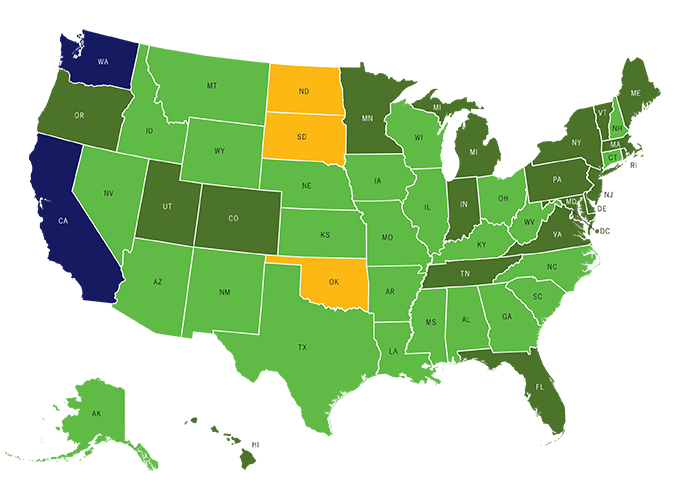Last month, the Safe Routes Partnership released the 2018 version of Making Strides: State Report Cards on Support for Walking, Bicycling, and Active Kids and Communities. The report cards rank states on their policy approaches on a range of areas, including Complete Streets, school siting, physical activity planning, and more.
The most relevant section for our federal policy blog is the second topic area of the report cards: Safe Routes to School and Active Transportation Funding, which looks at how each state is utilizing its Transportation Alternatives Program (TAP) to support biking, walking, and Safe Routes to School. This section is where the rubber meets the road—or rather, where the sole of the shoe meets the sidewalk! We push for federal policy and funding for biking and walking—but it’s up to your state department of transportation to get that funding out the door and support biking and walking.
Profiling Two States
Please see the full report for all the details on your state’s ranking and what each of the indicators and scores mean. All those numbers provide an opportunity for change. Two short case studies follow: Idaho, which improved since 2016, and Maryland, which declined since 2016.


2018 Overall Scores Map
Maryland is an example of some lost opportunity. Maryland’s score declined from 45 in 2016, which was good enough for the second-highest Making Strides category, to 21, which dropped it down one category to Warming Up. There were two main factors to Maryland’s lower score:
- In 2016, Maryland safeguarded all of its TAP money to use for biking and walking. Since then, Maryland has started transferring or letting TAP funding lapse, meaning there’s 20 percent less funding available for biking and walking.
- In addition, Maryland eliminated its standalone Safe Routes to School application and does not provide Safe Routes to School projects with any extra points or special consideration in the TAP application process.
Idaho is a great example of how significant change is possible in just two short years. Idaho’s 2016 score was 16 points, which put it in the lowest Lacing Up category. Now, they netted 45 points, which is in the second-best Making Strides category, a leap up two grades. Idaho made TAP more accessible through several changes:
- In the first year of TAP implementation, Idaho transferred 50 percent of TAP to other uses. However, they have never transferred any funding again, dropping their overall percentage of TAP funds transferred from 16 percent to 8 percent.
- Idaho also continues to improve its obligation of TAP funds, from 50 percent to 68 percent, meaning it is working hard to get project funds to winning award recipients.
- It also prioritizes Safe Routes to School projects in TAP competitions both through extra points for projects near schools and by also targeting 25 to 40 percent of TAP funding for Safe Routes to School projects.
- The state legislature created a state program to support child pedestrian safety improvements using general funds.
- Finally, Idaho just awarded funding to create a new statewide resource center to help Safe Routes to School initiatives all across the state.
What you can do in your state
The case studies show that it is possible to work with your state to make TAP more accessible and supportive—and on the contrary, that a state’s performance can decline if advocates don’t keep the pressure on. Here’s what you can do in your state:
- Download the 2018 state report cards and examine your state’s scores
- Compare it to your state’s 2016 scores to see whether there are any changes
- Keep an eye on your state’s progress in between report cards with our quarterly “state of the states” assessments
- Identify areas of potential improvement in your state (i.e. where scores are low)
- Reach out to other biking and walking advocates around the state to see if you can work together
- If you have questions or need more detail on your state, please reach out to Margo Pedroso at margo@saferoutespartnership.org
- Work with your state department of transportation (and other leaders such as your Governor or legislators) to push for changes
- Keep us posted on your goals and progress at margo@saferoutespartnership.org!
With your help—we can get those state ratings even higher in 2020. And, by doing so, it shows Congress that the Transportation Alternatives Program is valued and needed, which we can leverage to increase funding for TAP in the next transportation reauthorization.

